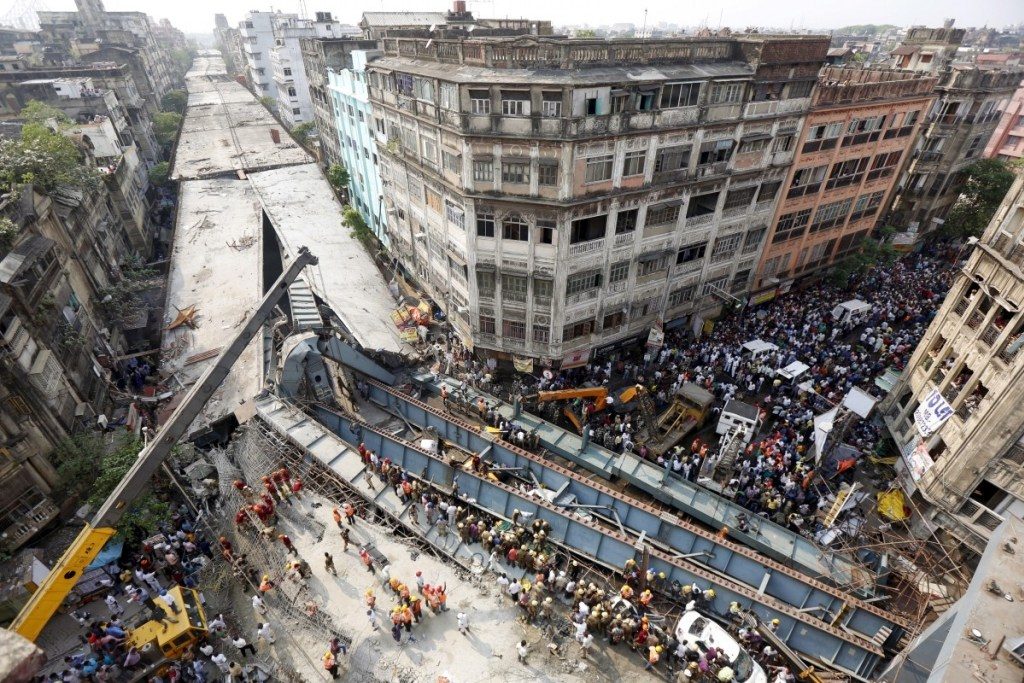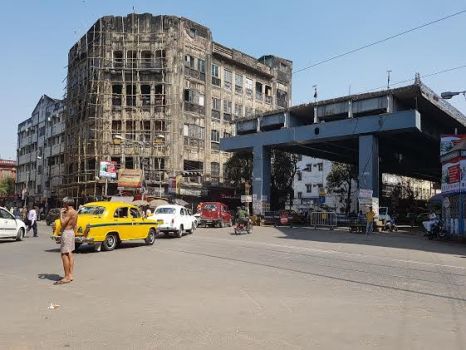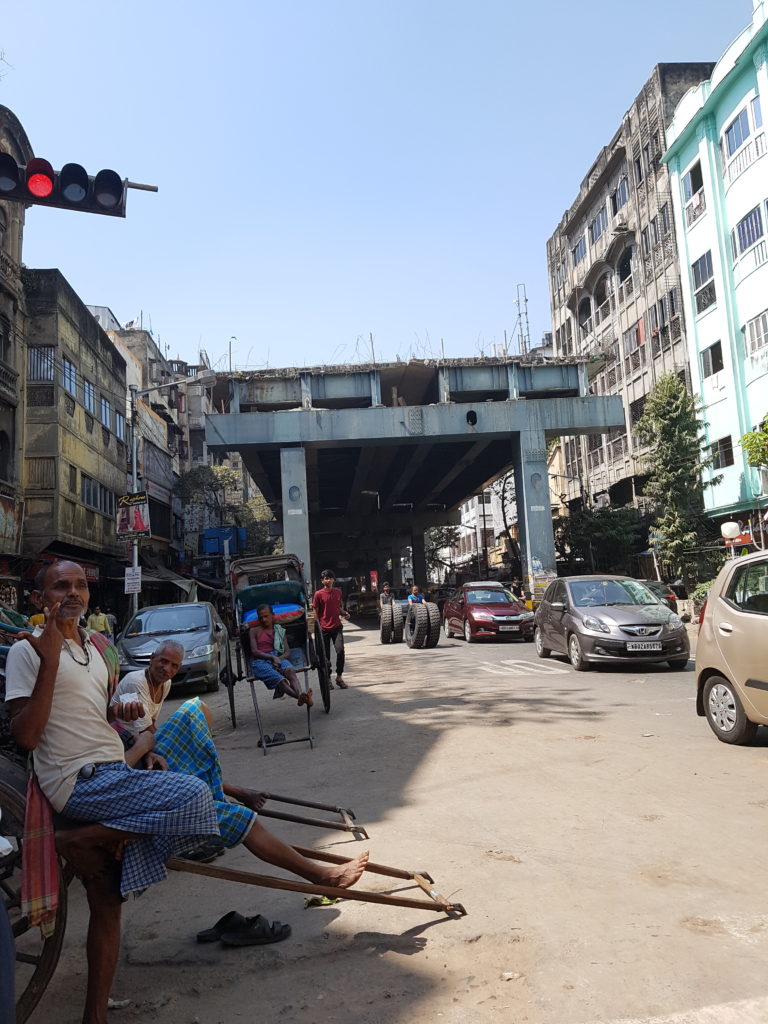More than one year since the Kolkata flyover collapse that killed 26, the criminal trial has not begun. The police are not speaking on the record. And the government is silent
Kolkata: If you went down Vivekananda Road in the direction of Girish Park metro station, it’s a cool, pleasantly-shaded walk until the Ganesh Talkies crossing, where the heat of the Kolkata summer hits you like a slap through an ugly hole of sky. This is the spot where the 60th section of the Vivekananda flyover, then under construction, collapsed at 12:32 pm on March 31, 2016, crushing 26 people to death.
Many of them were hurrying to work at Burra Bazaar, said to be the largest commercial district in eastern India. Sanjay Mehrotra, 50, was walking to his family yarn store after a lunch that felt too full. A mother had set out to pick up her children from school, others were going to the bank, a couple were on the way to visit family in a nearby hospital. Some were at work: among the dead were rickshaw pullers, cab drivers, street vendors and men still unidentified in the police records. According to the police, 20 people were treated for injuries.

The flyover that collapsed in Kolkata on March 31, 2016. Credit: Reuters
(taken from the The Wire.in website)
“It is like an act of god,” A.G.K. Murthy, the operations director of IVRCL, had said on the day of the accident. IVRCL is the company constructing the flyover. Sheela Peddinti, the company’s legal adviser, said two days later, “The glass was shattered. It could have been a blast.” But despite these statements, to this day, the company carries only a press release dated March 31, 2016, on its website “grieving” the incident. And although this document carries an email address, the company repeatedly ignored email and telephone requests for responses over the months of February and March 2017, as the one-year-anniversary of the accident drew near.
When contacted through their defence lawyer on two occasions, they refused each time.
Across the crossing, the rest of the flyover stands as before, snugly fitted into the balconies and parapets of houses before abruptly halting mid-road. This is how the damaged flyover has stood since the rescue operations to excavate people buried under the crush of steel and concrete ceased.
The case so far
One year and a few days after the accident, the criminal trial into the accident has not begun. Sixteen persons were arrested on charges of culpable homicide not amounting to murder and other related charges. All 16 are now out on bail.
Ten of those charged are management-level officials of IVRCL. Two are senior officials of the Kolkata Metropolitan Development Authority (KMDA), the urban planning and development authority of the West Bengal government for the larger Kolkata area. In the legal agreement for this project, KMDA has been identified as the employer.
Additionally, two persons from Anindita Enterprises, one from Equtep Engineers and Associated Pvt. Ltd. and one from the Indian Registrar of Shipping (IRS) – all subcontracted by IVRCL – have been charged. Of them, Equtep had been tasked with designing the flyover and the IRS, with quality control. The charges are under sections 304 (culpable homicide not amounting to murder), 308 (attempt to commit culpable homicide), 427 (mischief causing damage to the amount of Rs 50) and 34 (acts done by several persons for a common intention).
Oddly, the police have been tight-lipped as well. Although one of the investigating officers spoke at length with The Wire, he refused to go on the record. A short check revealed that every English newspaper in the city that had followed up on the accident quoted ‘sources’ or ‘officers’ in the police. This kind of secrecy seems unwarranted. An order passed by the chief information commissioner in November 2014 deems a chargesheet to be a “public document”. However, it also adds that there may be information within that needs to be kept confidential. “Thus, [a] chargesheet can neither be prevented en bloc for disclosure nor disclosed totally.”

The half-bridge as it stands near Burra Bazaar, Kolkata.
Credit: Sohini Chattopadhyay
After filing three Right to Information (RTI) appeals, I received permission to access the document. Interestingly, the Kolkata police rejected the RTI appeal filed to them. Although the RTI response did not mention partial access, I was handed only about 50 pages of the case files. The police say they have filed more than 3,500 pages in charges – and need to file some more. The trial can begin only when the entire chargesheet has been filed.
In any case, to file for documents before the Kolkata courts is to realise how little an RTI order counts for before the vast smirking army of court clerks. No explanation was given for the partial access. Reporting from a chargesheet should be a straightforward thing; it is the official record of investigation. In this case, with this kind of pressure-cooker secrecy, it felt odd, disquieting even.
Absentee Chinese partner
Still, even a limited view of the charges filed offers a picture of widespread reckless malpractices, from the beginning and right from the top. In December 2008, when tenders were invited for constructing the Vivekananda flyover under the Central government’s Jawaharlal Nehru National Urban Renewal Mission, IVRCL bid for the project jointly with a Chinese company named China Railway 18th Bureau Group Co. Ltd. (CR18G). IVRCL and CR18G collaboratively proposed to deliver the flyover at a cost of Rs 164.63 crore in 18 months, beating out three other shortlisted companies (Gammon India, Sirplex and Tantia Construction). In this project, the KMDA is again the employer, and CR18G-IVRCL the contractor.
According to documents found by the Kolkata police, CR18G was listed as the lead partner in the project, responsible for 70% of the costs, benefits and liabilities. IVRCL stood for the remaining 30%. To this end, CR18G was also tasked with providing “experienced personnel” for the project. But in reality, police say, the Chinese company was a “silent partner”. They wrote: “Representatives of CR18G have never visited the project site. IVRCL has failed to… substantiate the [reasons for the] absence of CR18G since inception of this project.”
The reason for the inclusion of the Chinese firm, a subsidiary of a Fortune 500 company, seems obvious – to bump up IVRCL’s chances of securing the bid.
‘Failed steel’ samples
The police have specifically identified that the accident was caused when two arms of the T-shaped pillar, identified in their record as Pier no. 40(C), buckled. Piers are vertical structural braces that hold up the elevated length of road in flyovers. The two arms of Pier 40(C) were found bent in the shape of an inverted ‘V’ – no wonder then that their collapse brought down a considerable section of the built-up structure.
The chargesheet is also particular, and doughty, about pointing fingers. For example, it says that the steel used to fabricate Pier 40(C) was well below the required strength.
Two plates of 36-mm steel and of a certain heat specification had been purchased from SAIL in August 2013 and sent to the Anindita Enterprises workshop in Dhulagarh. Anindita Enterprises had been hired for fabricating steel. The requisite ‘impact value’ – the energy expended to cause a particular amount of deformation – of the steel was fixed at 25 J. When the IRS, appointed in the project for quality checks, tested this steel, it was found to have an impact value of only 9.33 J.
IRS collected a second sample from the Dhulagarh workshop for testing in October 2013. This time, too, it failed: the impact value was found to be 12.66 J. After this, a third sample of the same heat specification was collected for testing – but from SAIL’s Dankuni yard. This third sample passed the impact value test. An IVRCL official then wrote to IRS to approve the steel sample.
The police have charged that the arms of Pier 40(C) were made by the “failed” steel sample materials in Anindita Enterprises’ Dhulagarh unit. In other words, rejected steel materials were knowingly used. The question then arises as to how many were in the know: officials of Anindita Enterprises alone or officials of the IVRCL, KMDA and IRS as well?
Unapproved drawings
If this wasn’t bad enough, the engineering drawing specifying the flyover’s design had not been vetted by the independent authority, Jadavpur University. This isn’t mentioned on the pages of the chargesheet (received through the RTI application). One afternoon, a lawyer connected with the case allowed me to pore over the documents for 15 minutes, and it was indeed listed in the case files. However, it isn’t clear if this detail has been included in the supplementary chargesheet.
The drawings and designs were courtesy Equtep. Protocol requires an independent expert – Jadavpur University, in this case – to vet the drawing. According to the police, a certain drawing had been sent to the university – let’s call it draft R0 – and it was approved. However, the flyover was not designed based on R0, but on a new draft called RI, and R1 hadn’t been cleared the university. In short, IVRCL worked on the basis of an unverified drawing.
This is a charge that is easier made than proved, said IVRCL’s lawyer Dibyaduti Sinha. “We have the drawing verified by Jadavpur. So we know protocol was followed and the independent expert was consulted. There are so many drawings made for a project like this, some of them may even be on file. How can you say that we were working on the basis of an unverified drawing?”
The other police findings this author saw listed were that the nuts and bolts used for temporary staging were of poor quality and that poorly-graded sand and coarse aggregates had been used for concreting.

Rickshaw pullers near the half-flyover in Kolkata
Credit: Sohini Chattopadhyay
However, a senior official at RITES, an engineering consultancy firm, said on condition of anonymity that the poor cement and sand quality are far less serious problems here. “When the design itself is faulty, these rank much further down the order,” he said. The government consults with RITES on transport, infrastructure and some associated technologies. RITES had been commissioned by the Kolkata police to conduct a probe into the accident. The official refused to discuss the contents of their report in detail except in the broadest of terms (because the case was sub judice): “Personally speaking, it’s best to raze the flyover. There is too little to salvage.” Another report into the accident has been prepared by IIT-Kharagpur; the institute’s director declined to discuss the report.
Immediately after the accident, the Kolkata media had suggested that the accident had been caused by corruption in the “syndicate” – the nexus between political parties and building-and-supplies contractors. Within two days, the ABP group zeroed in on Trinamool Congress MLA Smita Bakshi’s nephew Rajat Bakshi, whose company Sandhyamani Contractors provided labourers for the flyover. The police investigation has not charged him in the case so far, however. In July 2016 a relieved Bakshi told the Times of India about his not being charged. His aunt had also won her assembly seat, interestingly from the same constituency where the flyover had fallen.
More callousness
How does a construction company get away with the use of ‘failed’ steel, unapproved drawings and with the presence of a ‘ghost’ contractor? More than anything, what these charges suggest is a stunning failure in supervision – the responsibility for which lies entirely with the party identified as the employer: KMDA – and, by implication, the state government. (The flyover was commissioned in 2008-2009 when the government was headed by the CPI(M); the Trinamool Congress was voted in in 2011). Both governments share responsibility for what happened.
And then there was also the firm IRS, hired expressly for conducting quality checks. How did all these measures fail?
Well before the accident, a Times of India report had identified two serious problems thought to have crippled this project from the start. First: the continual delay in KMDA’s acquiring the requisite land. Second: the always-daunting challenge of erecting a flyover in a congested area like Burra Bazaar. As many residents had discovered to their shock, the structure of the flyover passes right through their verandahs or immediately under/above their parapets. Some residents went to court to protest this. All of this contributed to a delay of several years. The agreement with IVRCL and CR18G had been signed in February 2009 and the project was supposed to have been delivered in 18 months, i.e. by August 2010. When it collapsed on March 31, 2016, about 25% work remained to be completed.
A New-Delhi-based legal expert specialising in infrastructure issues told The Wire, “Such a delay by itself points to horrendous project management and very suspect oversight by the relevant government authority. The blame for that cannot fall anywhere other than with KMDA and by extension its controlling agency, the Government of West Bengal.” He added that it is difficult to comment on IVRCL’s liability without knowing what kind of agreement the company had signed with KMDA – for instance, a public-private partnership contract, a works contract or something else. Whatever the case, he said, “The delay itself … would eventually be sufficient, legally, to negate any liability on IVRCL.”
(Several emails to the relevant West Bengal government department requesting its views on the flyover collapse have gone unanswered – as have multiple phone calls and SMSes to the respective civil servants and their offices. Eventually, the chief secretary’s staff asked me to contact the urban development secretary. The story will be updated when an official response is available.)
The story was published by The Wire.in